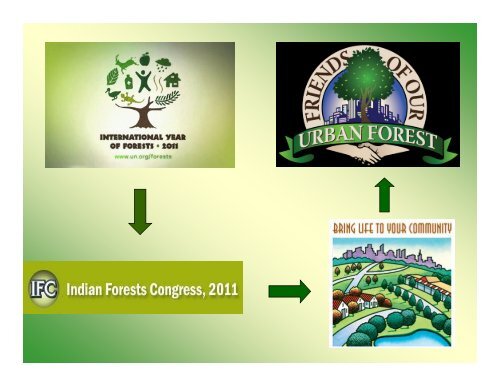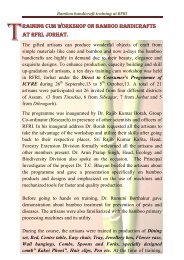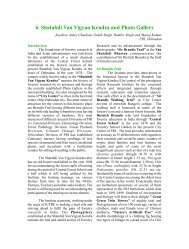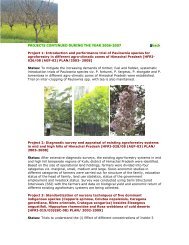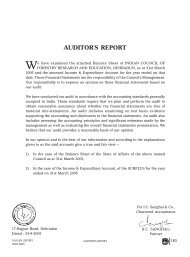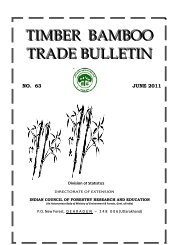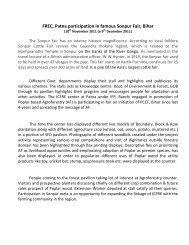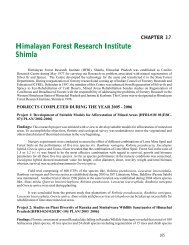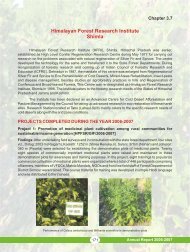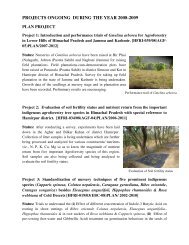Assessment of Tree Health along Trevor Road, New Forest ... - ICFRE
Assessment of Tree Health along Trevor Road, New Forest ... - ICFRE
Assessment of Tree Health along Trevor Road, New Forest ... - ICFRE
You also want an ePaper? Increase the reach of your titles
YUMPU automatically turns print PDFs into web optimized ePapers that Google loves.
From the collections <strong>of</strong> Dr. N.S.K Harsh
<strong>Assessment</strong> <strong>of</strong> <strong>Tree</strong> <strong>Health</strong> <strong>along</strong> <strong>Trevor</strong> <strong>Road</strong>,<br />
<strong>New</strong> <strong>Forest</strong>, Dehradun: A Case Study<br />
By<br />
Kavita and Dr. N.S.K Harsh<br />
<strong>Forest</strong> Pathology Division<br />
<strong>Forest</strong> Research Institute<br />
Dehradun
<strong>Forest</strong>s in urban landscape<br />
Occurrence:-<br />
<strong>along</strong> railway lines,<br />
<strong>along</strong> canal banks,<br />
<strong>along</strong> tank bed and<br />
<strong>along</strong> road sides etc.<br />
Benefits:-<br />
Productive viz. timber, fuel, NTFPs etc.<br />
Protective viz. earth’s air purifier, climate<br />
amelioration, soil and water conservation,<br />
wildlife habitat etc.
Protecting trees from construction damage, A home owner’s guide by Gary R. Johnson)
Objectives<br />
Study <strong>of</strong> all the defects and diseases <strong>of</strong><br />
trees on the <strong>Trevor</strong> <strong>Road</strong><br />
Biotic and abiotic factors which affect the<br />
tree vigour<br />
Categorization into various hazard tree<br />
categories on the basis <strong>of</strong> study<br />
Suggestions to improve the condition<br />
<strong>of</strong> <strong>Road</strong> side plantation
Methodology Used<br />
Selection <strong>of</strong> Study Area i.e. <strong>Trevor</strong> <strong>Road</strong>, FRI, <strong>New</strong> <strong>Forest</strong><br />
Division <strong>of</strong> road into three sections i.e. Section “A” from Shatabdi<br />
dwar to Wilmot crossing, Section “B” from Wilmot crossing to Hart<br />
<strong>Road</strong> crossing and then Section “C” from Hart <strong>Road</strong> crossing upto<br />
Hill <strong>Road</strong><br />
Numbering <strong>of</strong> trees <strong>of</strong> left and right hand side separately from<br />
shatabdi dwar.<br />
Section “A”<br />
Section “B”<br />
Section “C”
Contd.<br />
Twenty five sub-factors under three main factors viz.<br />
types <strong>of</strong> defects, soil conditions and human interference<br />
were taken for study.<br />
Types <strong>of</strong> defects include dead tree or branches, diseased<br />
tree, root problems, cracks, weak branch union, poor<br />
architecture and epiphytes<br />
Soil conditions were studied on the basis <strong>of</strong> soil grade and<br />
compactness.<br />
Foot/ vehicle trampling, electricity wiring, nails around<br />
branches, domestic wastes, pole and trenches within the<br />
protected root zone suggests the human interference<br />
25 factors and result table
Result’s table<br />
Results<br />
Summery <strong>of</strong> results <strong>of</strong> Section “A”<br />
<strong>Tree</strong> species and their numbers<br />
Name <strong>of</strong> tree species<br />
Number <strong>of</strong><br />
trees<br />
Grevillea robusta 59<br />
Syzygium cuminii 10<br />
Sapindus mukorossi 4<br />
Bauhinia variegata 4<br />
Terminalia arjuna 2<br />
Mangifera indica 3<br />
Terminalia calamansanai 3<br />
Grewia optiva 1<br />
Terminalia tomentosa 1<br />
Unknown 1<br />
<strong>Tree</strong> distribution <strong>of</strong> Study Section "A"<br />
Grevillea robusta<br />
Syzygium cuminii<br />
Sapindus<br />
mukorossi<br />
T. calamansanai<br />
Terminalia arjuna<br />
Mangifera indica<br />
Bauhinia variegata<br />
Grewia optiva<br />
Unknown
Distribution <strong>of</strong> decaying fungi in section “A”<br />
Name <strong>of</strong> <strong>Tree</strong><br />
species<br />
Grevillea robusta<br />
Grevillea robusta<br />
Syzygium cuminii<br />
Sapindus<br />
mukorossi<br />
Name <strong>of</strong><br />
Sporophore<br />
Hexagonia<br />
tenuis<br />
Phellinus<br />
durissimus<br />
Phellinus<br />
caryophylli<br />
Hexagonia<br />
tenuis<br />
No <strong>of</strong> <strong>Tree</strong>s<br />
Grewia optiva unknown 1<br />
Delonix regia unknown 1<br />
Distribution <strong>of</strong> decaying fungi in Section “A"<br />
Grevillea robusta<br />
Hexagonia tenuis<br />
Grevillea robusta<br />
P. durissimus<br />
Syzygium cuminii<br />
P.caryophylli<br />
S. mukorossi<br />
Hexagonia tenuis<br />
25<br />
1<br />
5<br />
1<br />
Hazard category wise distribution <strong>of</strong> trees<br />
Category<br />
No. <strong>of</strong> <strong>Tree</strong>s<br />
High Hazard 19<br />
Moderate Hazard 37<br />
Low Hazard 33<br />
Distribution <strong>of</strong> <strong>Tree</strong>s according to<br />
Hazardous Category<br />
High Hazard<br />
Moderate Hazard<br />
Low Hazard<br />
Grewia optiva<br />
unknown<br />
Delonix regia<br />
unknown<br />
Relationship from the Height-Girth Ratio and Hazard Category:<br />
Height: Girth ratio range<br />
Hazard category<br />
6 – 11 ‘1’ or ‘2’<br />
11 – 14 ‘2’ or ‘3’<br />
>14 ‘3’<br />
Value <strong>of</strong> correlation coefficient between the two = 0.405
Summary <strong>of</strong> Section “B” <strong>Trevor</strong> <strong>Road</strong><br />
<strong>Tree</strong> distribution in section “B”<br />
<strong>Tree</strong> Species<br />
Number <strong>of</strong> <strong>Tree</strong>s<br />
Eucalyptus spp. 28<br />
Chorisia speciosa 27<br />
Bombax ceiba 3<br />
Adenanthera microsperma 2<br />
Litsea monosperma 1<br />
Ficus glomerata 1<br />
Bauhinia variegata 1<br />
Grevillea robusta 1<br />
<strong>Tree</strong> Distribution <strong>of</strong> Study Section "B"<br />
Eucalyptus spp.<br />
Distribution <strong>of</strong> decay fungi in Section “B”<br />
Name <strong>of</strong> <strong>Tree</strong><br />
species<br />
Adenanthera<br />
microsperma<br />
Adenanthera<br />
microsperma<br />
Name <strong>of</strong> Sporophore<br />
Phyloporia ribis,<br />
Ganoderma<br />
lucidum<br />
No.<br />
1<br />
Unknown 1<br />
Chorisia speciosa Hexagonia tenuis 3<br />
Eucalyptus spp. Phellinus caryophylli 1<br />
Eucalyptus spp. Phellinus calcitratus 2<br />
Eucalyptus spp. Hexagonia tenuis 8<br />
Litsea<br />
monosperma<br />
Bauhinia<br />
variagata<br />
Hexagonia tenuis 1<br />
Hexagonia tenuis 1<br />
Chorisia<br />
speciosa<br />
Bombax ceiba<br />
Ddistribution <strong>of</strong> Decaying fungi in Section "B"<br />
Adenanthera<br />
microsperma<br />
Litsea<br />
monosperma<br />
Ficus glomerata<br />
Bauhinia<br />
variagata<br />
Grevillea robusta<br />
A. microsperma Phyloporia<br />
ribis,Ganoderma lucidum<br />
A. microsperma Unknown<br />
C. speciosa Hexagonia tenuis<br />
Eucalyptus spp. Phellinus<br />
caryophylli<br />
Eucalyptus spp. Phellinus<br />
calcitratus<br />
Eucalyptus spp. Hexagonia<br />
tenuis<br />
L. monosperma Hexagonia<br />
tenuis<br />
B. variagata Hexagonia tenuis
Hazard category wise tree distribution<br />
Category<br />
No. <strong>of</strong> <strong>Tree</strong>s<br />
Distribution <strong>of</strong> <strong>Tree</strong>s according to Hazardous<br />
Category<br />
High Hazard 25<br />
Moderate Hazard 23<br />
High Hazard<br />
Moderate Hazard<br />
Low Hazard<br />
Low Hazard 16<br />
Relationship from the Height-Girth Ratio and Hazard Category:<br />
Height: Girth ratio range Hazard category<br />
6 – 11 ‘1’ , ‘2’ or ‘3’<br />
11 – 14 ‘1’ or ‘2’<br />
14 ‘2’<br />
Value <strong>of</strong> correlation coefficient between H:G and HC= 0.0405
Summery <strong>of</strong> section “C” <strong>of</strong> <strong>Trevor</strong> <strong>Road</strong><br />
<strong>Tree</strong> distribution in the section<br />
<strong>Tree</strong> species<br />
Number <strong>of</strong><br />
<strong>Tree</strong>s<br />
<strong>Tree</strong> Distribution <strong>of</strong> Study Section "C"<br />
Syzygium cuminii 44<br />
Syzygium cuminii<br />
Lagerstroemia flosreginae<br />
29<br />
Lagerstroemia<br />
reginae<br />
Distribution <strong>of</strong> decaying fungi in section “C”<br />
Name <strong>of</strong> <strong>Tree</strong><br />
species<br />
Name <strong>of</strong> Sporophore<br />
No <strong>of</strong><br />
<strong>Tree</strong>s<br />
Syzygium cuminii Polyporus xanthopus 2<br />
Syzygium cuminii Ganoderma spp. 1<br />
Syzygium cuminii Hexagonia tenuis 7<br />
Distribution <strong>of</strong> decaying fungi in Section "C"<br />
Syzygium cuminii<br />
Polyporus<br />
xanthopus<br />
Syzygium cuminii<br />
Ganoderma spp.<br />
Syzygium cuminii<br />
Hexagonia tenuis<br />
Lagerstroemia flosreginae<br />
Lagerstroemia flosreginae<br />
Phellinus caryophylli 6<br />
Ganoderma<br />
applanatum<br />
2<br />
Lagerstroemia flosreginae<br />
Phellinus<br />
caryophylli<br />
Lagerstroemia flosreginae<br />
G.<br />
applanatum<br />
Hazard category wise tree distribution<br />
Category<br />
Number <strong>of</strong><br />
<strong>Tree</strong>s<br />
High Hazard 31<br />
Moderate Hazard 29<br />
Distribution <strong>of</strong> <strong>Tree</strong>s according to Hazardous<br />
Categories<br />
High Hazard<br />
Moderate Hazard<br />
Low Hazard<br />
Low Hazard 13
Relationship from the Height-Girth Ratio and Hazard Category:<br />
Height: Girth ratio range<br />
Hazard category<br />
3 – 9 ‘1’<br />
9 – 15 ‘2’ or ‘3’<br />
>15 ‘3’<br />
Value <strong>of</strong> correlation coefficient between H:G and HC= 0.591<br />
Only 3 trees out <strong>of</strong> 73 are with height- girth ratio greater than<br />
15
Condition <strong>of</strong> <strong>Tree</strong>s on <strong>Trevor</strong> <strong>Road</strong>
Damaged trees after storm <strong>of</strong> 19 april,2010
Preventive and Remedial Measures<br />
As all the trees whether they are in hazard category 1, 2 or 3 are potential hazards for the life and<br />
property and the only way to completely eliminate a tree hazard is its removal. Complete removal<br />
<strong>of</strong> all the trees is not acceptable; moreover it is also not suggestible. However, trees <strong>of</strong> hazard<br />
category “1” should be replaced immediately as they are the trees facing maximum number <strong>of</strong><br />
problems with severe decay and for hazard category “2” and “3”, preventive and remedial<br />
measures should be applied.<br />
Preventive measures:<br />
During construction <strong>of</strong> roads, walls, trenches for cabling and drains near the trees they are<br />
commonly exposed to following injuries:<br />
1. Stem wounds 2. Root Wounds 3. Fill.<br />
To avoid all these problems, design and construction should be carefully planned to avoid tree<br />
damage. Soil mounding around the tree bases should be leveled. Grass cutting near the tree bases<br />
need to be done carefully.<br />
Remedial measures:<br />
Policy decision for removal <strong>of</strong> trees in hazard category ‘1’ and/or their treatment should be<br />
worked out. <strong>New</strong> plantation need to be carried out with proper planning, spacing and suitable<br />
species as replacement. Take people into confidence for removal <strong>of</strong> trees and branches to avoid<br />
queries, petitions and explanations.<br />
Proper pruning followed by wound dressing can take care <strong>of</strong> large dead branches and tops <strong>of</strong> the<br />
trees which are having poor architecture because <strong>of</strong> large branches. Canopy reduction is also<br />
advisable for the trees affected by root diseases and stresses. This will maintain the balance <strong>of</strong> the<br />
canopy and the roots.
Instead <strong>of</strong> blazing, for tree numbering and naming, small stainless steel nails should be used for<br />
numbering or naming the trees (Bakshi et al. 1963).<br />
For cavity treatment, first decayed wood should be removed and then cavity should be filled<br />
with inert material like polyurethane foam after surface treatment with fungicides like<br />
Tridemefon.<br />
Epiphytes such as Ficus spp. which are in their young age and phanerogamic plant parasites<br />
such as Loranthus spp. should be removed from the trees. Epiphytes at later stages may<br />
completely strangulate the tree and phanerogamic plant parasites reduce the vigour <strong>of</strong> the trees.<br />
Remove wires attached to the trees/ branches and in future avoid wiring the branches as they<br />
cause girdling.<br />
Dead and decaying branches should be removed before seasons <strong>of</strong> storms and rains by regular<br />
examination <strong>of</strong> trees.<br />
Forks should be examined and one <strong>of</strong> the branches should be removed to create balance<br />
followed by treatment <strong>of</strong> cut ends.<br />
Remove sporophores (fruit bodies) <strong>of</strong> fungi from the trees and burn them as they produce<br />
innumerable spores spreading the infection to neighbouring and other trees.
Conclusion<br />
The health status and condition <strong>of</strong> trees<br />
growing <strong>along</strong> <strong>Trevor</strong> road in <strong>New</strong> <strong>Forest</strong> campus,<br />
Dehradun have been assessed and it was found<br />
that the trees are showing different hazard<br />
categories, as many as 75 trees are falling in<br />
hazard category “1” and 90 trees are in category<br />
“2”. Various biotic and abiotic stresses have been<br />
attributed to the condition <strong>of</strong> trees. Preventive and<br />
remedial measures have been recommended which<br />
need to be applied immediately to check for the<br />
deterioration <strong>of</strong> the condition <strong>of</strong> trees.
Acknowledgements<br />
I <strong>of</strong>fer my sincere gratitude and personal regards to my, competent and<br />
reverent supervisor Dr. N. S. K. Harsh, Scientist F, Head <strong>of</strong> <strong>Forest</strong><br />
Pathology Division <strong>of</strong> F.R.I Dehradun, for judicious leadership, valuable<br />
discussions, extensive ideas, constructive criticism, constant<br />
encouragement support during the entire period <strong>of</strong> my work.<br />
I awe my sincere thanks to Director FRI, Dean FRIU and also my Course<br />
Coordinator for giving me the opportunity to work on this project.<br />
My grateful thanks to Dr. Amit Asthana, Dr. S.D. Sharma, Mr. D. P. Singh<br />
for their help in GIS lab.<br />
I awe my gratitude towards Dr. Amit Pandey, Dr. Parthsarthi Mohanty,<br />
Ms. Pooja Arya, Ms. Shailja Rawat & Ms. Sona Singh for their constant<br />
help in lab.<br />
I am also thankful to all my friends for their constant support.<br />
I am pleased to express my grateful thanks towards the persons who met me<br />
in every morning during my work, took interest and appreciated specially Mr.<br />
R. V. Singh, Retired Director General <strong>of</strong> <strong>ICFRE</strong>, and Mr. Vijay Rawat, IFS.<br />
I also owe my gratitude to my parents who encouraged me throughout the<br />
tenure <strong>of</strong> my research work.<br />
And ultimately I wish to thank almighty ‘God’ supreme power <strong>of</strong> Universe.


